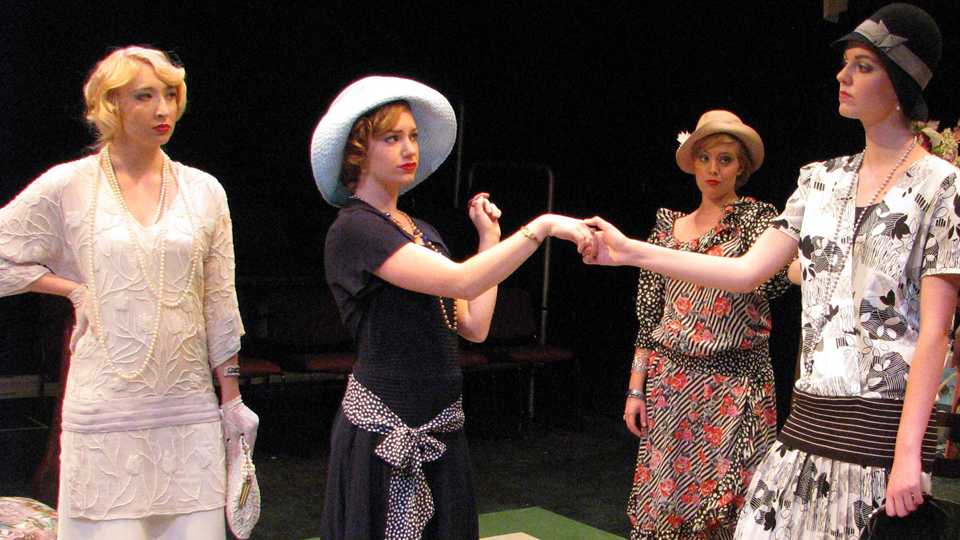Semi-Monde by Noel Coward is not a plot-driven show. Its primary concern is character, which means it’s the actor’s job to develop said character through both the text they have and the text they don’t.
The play’s setting—an expensive Paris hotel in the 1920s—perfectly echoes the people in it. Innumerable walk-on parts of well-dressed women on the arms of their men, glancing over their shoulders and giggling behind their hands, create layered characters in a matter of seconds and immerse the audience in the frivolous, supposedly carefree world of elite globetrotters.
Underneath the façade of correctness, though, lies a world rich in deceit. Semi-Monde quickly becomes a narrative of encounters between men and women who, almost as a rule, are not who they appear to be. This is conveyed not through the lines themselves, but in the delivery, the subtleties of inflection. A bit of emphasis on one word, a hesitation, or a glance is the only clue to distinguishing between what is said and the truth.
The main part of the stage is taken up by a restaurant, with the lobby at one end and a bar at the other. It’s difficult to speak about left and right in Semi-Monde, since the audience is seated in a sort of tunnel or aisle. This arrangement works brilliantly when paired with the socially interactive nature of the play; it makes the audience feel like they’re part of the action, deeply involved in the lives of the characters. The seating also creates intimacy, bringing more of the audience close to the actors without leaving anyone at the back of a dark proscenium.
The design of the show was admirable, striking a balance between simplicity and luxury. The chairs, desks, bar, and chandeliers all contributed to the effect, creating three-dimensional world that felt like it could be inhabited. One somewhat confusing, sometimes distracting element of design was the way the lights faded out after some scenes. The transition from chiefly yellow or white light to darkness was not linear but went through pink and blue hues, drawing my attention away from the actors and making me wonder about the technical aspects and purpose of the lighting.
This first show in Theatre Erindale’s 2012/13 season incorporates the entire graduating class, and Semi-Monde is a show brilliantly selected for this purpose. With very few characters that stand out as “stars”, the text gives everyone their share of stage time. The cast dynamic is one of unity; each actor is both unique and part of the bigger picture. Not one had to struggle to wear the physicality, including the hats, of the ’20s bourgeoisie; they moved comfortably in the silky drop-waist dresses and formal blazers.
A few performers, though, were cast with particular accuracy to really exploit their skill and diversity. Hailey Gillis as Tanis Marshall, Elizabeth Stuart-Morris as Dorothy Price, and Owen Fawcett as Julius Levenovitch and Edgar Darrell gave particularly polished performances, executing the language and the double-crossing of the play with astonishing grace.
What made the acting truly immersive was that nobody ever seemed to rest. The characters would often sit alone or in groups in the crowded dining room to the side, and these side-scenes never appeared passive. Even if the characters themselves were supposed to be intensely bored, there was still a sense of activity about them. At times the temptation to watch the people seated around the main action instead of in it was incredible, as each table’s occupants sorted through their own miniature plots and problems and relationships. One favourite was when Joshua, played by Lindsey Middleton, exchanged his near-empty drink glass for his companion’s nearly full one when said companion (Jaime Hernandez Lujan as Luke Bellows) left the table for a moment. Upon Luke’s return, Joshua denied having switched the drinks while he calmly downed the one he stole. This entire exchange took place without audible words, only with eye contact, hand gestures, and a couple of mouthed suggestions.
Overall, Semi-Monde was a rewarding show, fraught with beauty and something Patrick Young, the artistic director of the theatre and drama studies program, called “claws […] sheathed in velvet”. This apt description of the scandal in Semi-Monde serves as a reminder that even the privileged elite of 90 years ago struggled in many of the same ways people do today.




Indubitably.
I agree with every sentence, phrase, and word penned in your review. A remarkable show, in conjunction with a beautifully written review. Kate, your words have true eloquence, unlike the eloquent facade put on by the wealthy characters in the show ;)
You must inform me when you write another review! I take great pleasure in your writing.